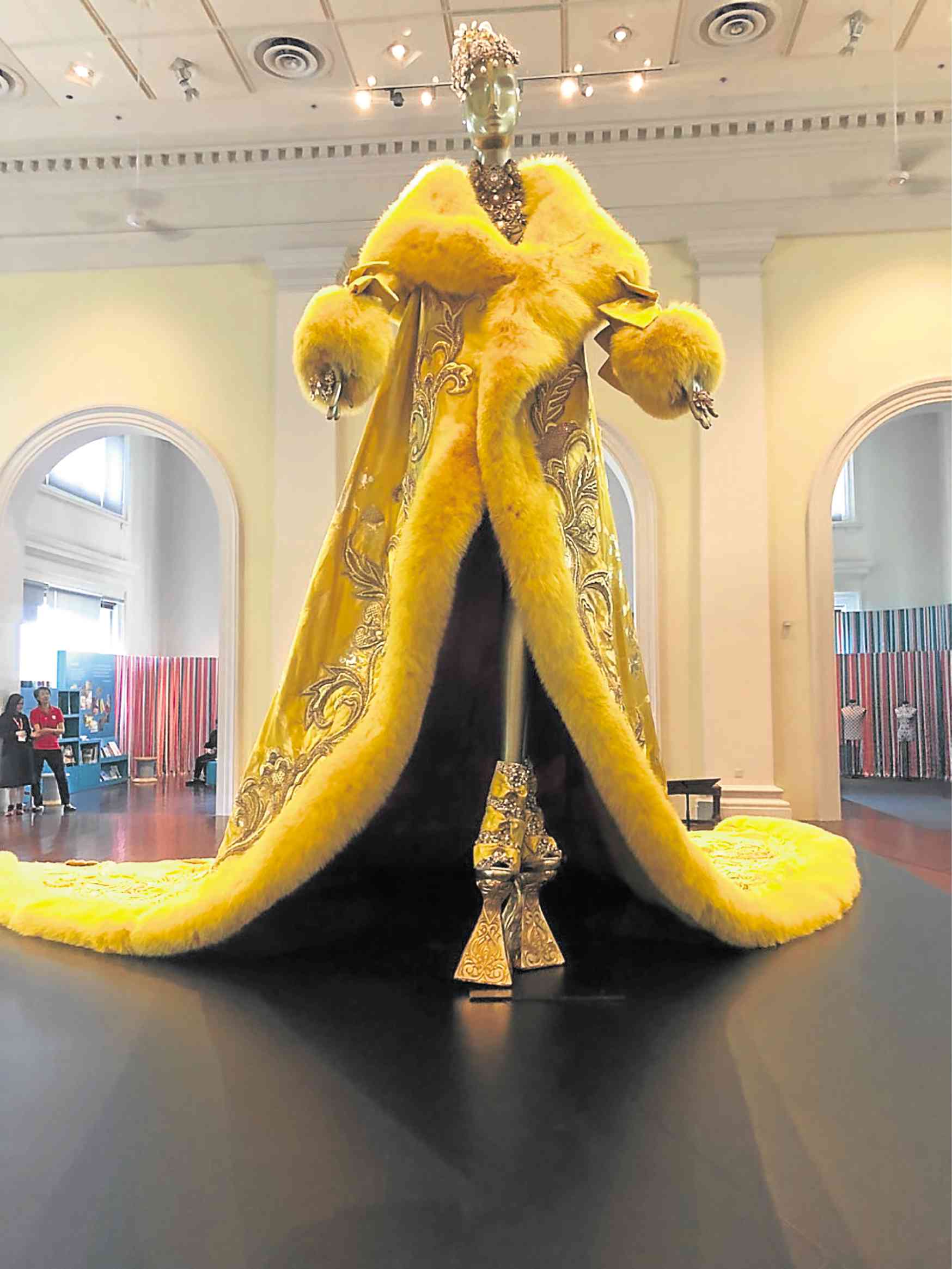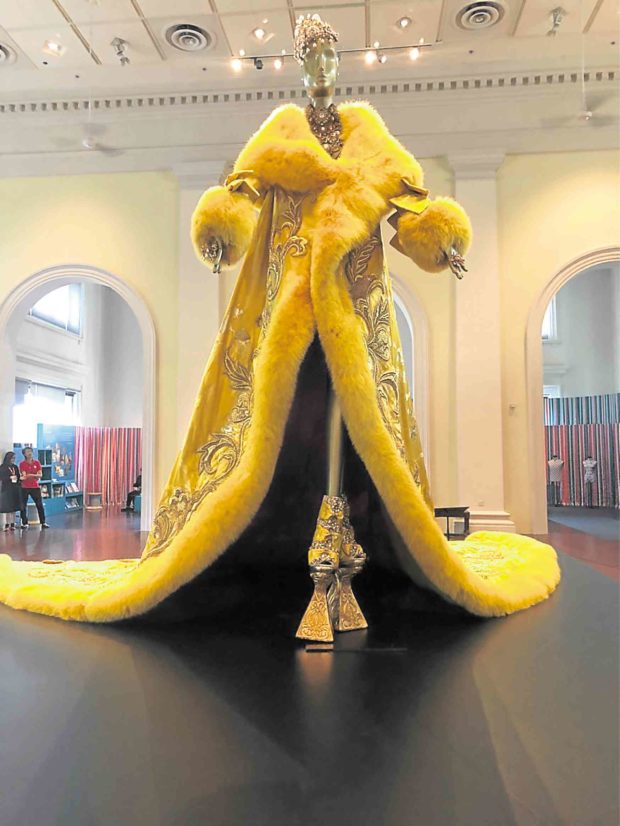
Highest of high fashion and the imperial splendor of Chinese history become a dazzling admixture in “Guo Pei: Chinese Art and Couture,” the smashing couture-cum-culture exhibit at the Asian Civilizations Museum (ACM).
Featuring 29 dresses by Guo Pei, it is the first fashion exhibit of the Singapore museum and perhaps the first retrospective for Guo Pei, whose name became an Internet sensation in 2015 when R&B singer Rihanna wore the Chinese designer’s sweeping “Yellow Queen” gown at the Met Gala in New York of the fashion exhibit, “China: Through the Looking Glass.”
Since then, Guo has been made honorary member of the Chambre Syndicale de la Haute Couture, only the second Asian to be so invited to the elite French group after Elie Saab of Lebanon.
Guo’s creations are notable for their seamless if theatrical blending of Chinese history and modern design. Chinese folk art (ceramics and porcelain), traditional embroidery and ancient motifs (silk flowers, peonies, butterflies, dragons, phoenixes) are integrated into her designs that however come with a contemporary idiom.
According to Vogue Australia, “She has single-handedly brought Chinese fashion to the Western world.”
Pei’s gowns are considered works of monumental art. Her Beijing atelier employs 500 people who labor on her designs cut by cut, stitch by stitch, minute by minute, hour by hour. Her “Magnificent Gold” gown from the Samsara collection in 2006 consisted of silk, wire, gold thread, silver-spun thread and Swarovski sequins, and took 50,000 hours to make.
But beyond the hosannas of the Western fashion press reeking of blatant capitalist marketing and cultural appropriation, Guo’s work is really about the melding of the old and the new, the fusion of history and aesthetics.
“Our aim is to make a point as to how heritage and tradition are very much relevant to the contemporary, that heritage and tradition can be remarkably sexy and alluring,” said ACM director Kenneth Ting. “Every masterpiece in the exhibit is a unique blend of contemporary and traditional design, material and craft.”
Signature
Even before the 2015 Met Gala, Guo had become the fashion designer of choice for the elite of China. In fact, the Chinese cape that Rihanna wore had been part of Guo’s 2010 haute couture collection. The singer stumbled upon it on the Internet and asked Pei if she could wear it.
The gown bore Guo’s signature: It took 66,000 hours or 22 months to make, was made of silk, metal thread, gold-spun thread and fox fur, and weighed 25 kg.
So heavy was the gown with the 4-meter train that Guo was afraid Rihanna would not be able to pull it off —literally—on the red carpet. But she did. In contrast, the model who had originally carried it in 2010 stopped her walk midway on the ramp and simply gave up.
Not surprisingly, “Yellow Queen” opens the ACM exhibit and provides a dramatic preface to the three main sections of the exhibit.
Imperial, global, traditional
“Gold is the Color of my Soul” evokes the imperial art of China. It presents a collection of Guo’s signature yellow and gold works, reflecting the historical significance of the color, as well as the design techniques and materials most associated with imperial China.

“China and the World” makes references to global Chinese art. Guo’s hybrid designs are displayed as representative of Chinese export art that blends
Oriental designs and Western silhouettes and tailoring.
“Treasured Heirlooms: Chinese Bridal Dress” is a nod to Chinese arts and crafts. It focuses on Guo’s bridal works, admittedly catering to her biggest market. The wedding gowns are presented as a modern updating or interpretation of traditional Chinese bridal style, with strong Peranakan connections, referring mainly to the Straits Chinese although also including the mixed heritages (Chinese, Indian, Malay and even European) of the peoples of Southeast Asia.
Ting noted that Guo’s visit of Singapore’s Peranakan Museum in 2009 proved decisive in Guo’s intercultural mixing of styles and design inspirations, especially in her bridal wear. (It’s a pity however that during Guo’s show at ACM, the Peranakan Museum is closed for renovation, depriving visitors of the the fashion exhibit of the chance to make cross-cultural inquiry into Guo’s creative process.)
To drive home the point that Guo’s creations are modern interpretations of Chinese history and heritage, ACM pits them with 20 Chinese design masterpieces from its collection.
For example, her “Magnificent Gold” ball gown, noted for its elaborate embroidery, is matched with a 15th-century Buddhist “thangka,” an ancient embroidered scroll. Her “Black-and-White Porcelain” gown is matched with a Ming Dynasty porcelain dish.
‘Manila shawl’
Meanwhile in “China and the World,” the trans-ocean impetus driving Chinese global art is represented by a fashion item that’s very recognizable to
Filipinos—the manton de Manila, or as the exhibit notes say, the “Manila shawl.”
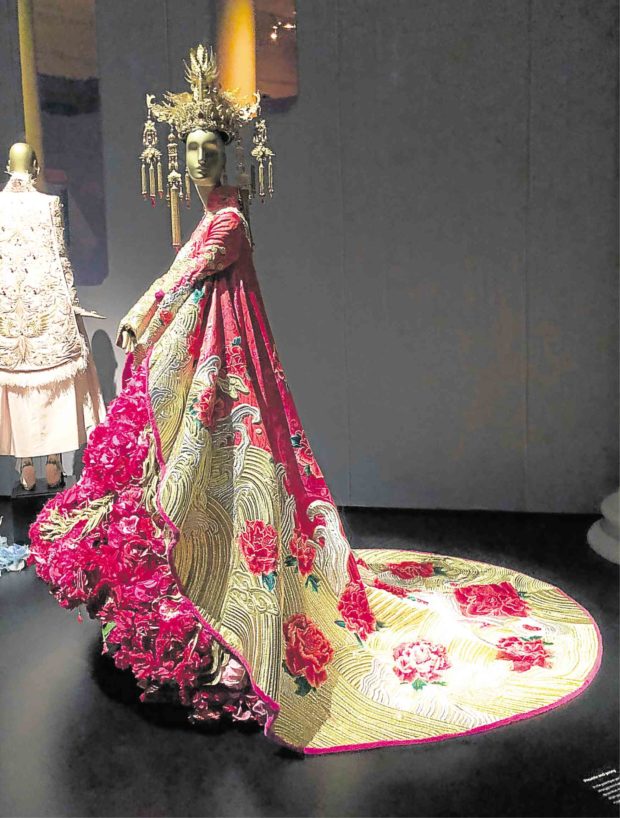
Made in Guangzhou, the shawl became an export state in the legendary galleon trade between Manila and Acapulco from the 16th to 19th centuries and became a fashion obsession in Europe so much so that in Spain, as the ACM exhibit notes, it has been “embraced as a traditional dress.”
Ting said that the exhibit, in fact, dovetails with the ACM’s mission to examine the diverse cultural heritage of Asia, interconnections within Asia, and Asian connections with the rest of the world.
During a “conversation” with Ting at the ACM River Room recently, to which the Inquirer was invited, Guo said an old Peranakan bridal gown brought to her by a bride-to-be for her to alter so impressed her that she didn’t want to return it later.
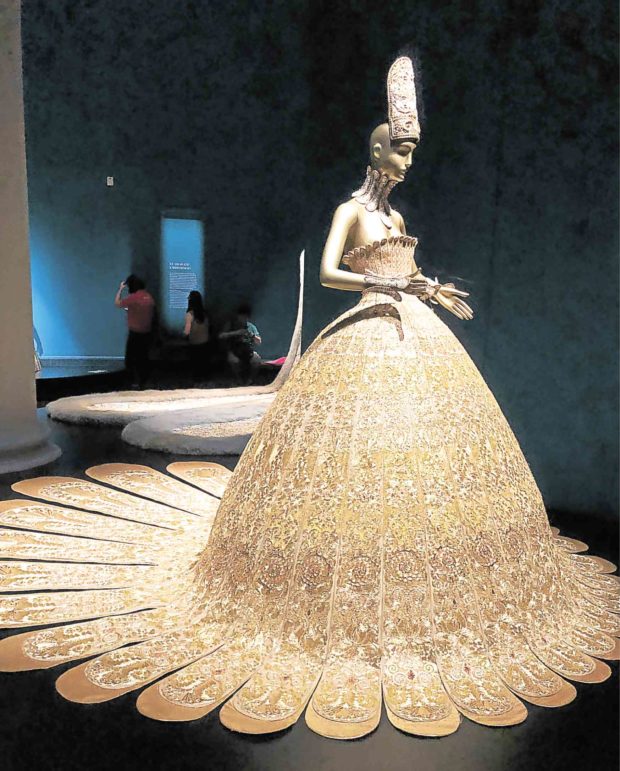
“It was the wedding dress 50 years ago of the bride’s mother-in-law,” said Guo, who’s 51 but looks 20 years younger and often speaks in gushing tones about art and fashion like an excited teenage girl. “I found it difficult to alter the dress for two to six months. Later I didn’t want to part with it.”
‘Gardens of the Soul’
Guo said she was born and raised in Beijing, and her mother and grandmother would take her for strolls as a child after dinner. At the old park, she would see engravings from the Qing Dynasty. At home she would listen to her grandma telling about ancient tales of magic and wonder and look at old clothes with traditional images of flowers and butterflies.
“I love my flowers,” she said. She added that one of her collections was called Gardens of Soul. “Everyone has a garden in his soul—you can enter it only if you put beautiful things in the garden,” she said. Sadly some people miss out on their garden, she said. “They haven’t done anything in the garden of their heart.”
Guo said she grew up with the conviction that “designing beautiful clothes would be my work.” She particularly wanted to design bridal dresses because “every woman must appear the most beautiful on her wedding day.”
While drawing from Chinese history and heritage, which she said was her “responsibility and mission,” Guo said she drew from other inspirations as well, evident in her Rihanna gown which was part of her 2010 collection, One Thousand and Two Nights.
Her influences are amorphous if not morbid. Her latest couture collection, Legend, was inspired by St. Gallen abbey and cathedral in Switzerland and Marie Antoinette’s imprisonment prior to the guillotine.
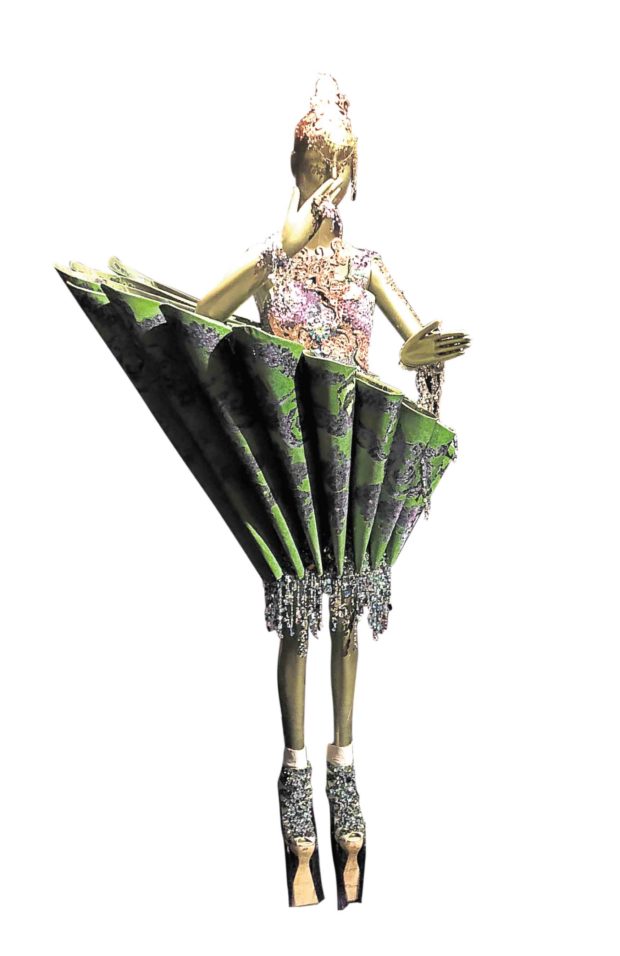
Guo said St. Gallen brought her “spiritual feeling,” an emotion of devotion that lent itself to the religious iconography that adorned the collection. But she combined this with the excess of Marie-Antoinette, who was imprisoned in the Conciergerie in Paris, where the collection was eventually shown.
Guo, in her conversation with Ting, said the Legend collection “was not so much about religion but what touched me was the belief, the belief that people have, how strong and powerful it is for human beings—the power to devote ourselves, to dedicate for love or for what we believe. It’s refreshing for the soul.”
Other than spiritual power and tending to the “Garden of the Soul,” Guo described her fashion by making references to athletics, not surprising for someone who had designed clothes for the Beijing Olympics in 2008.
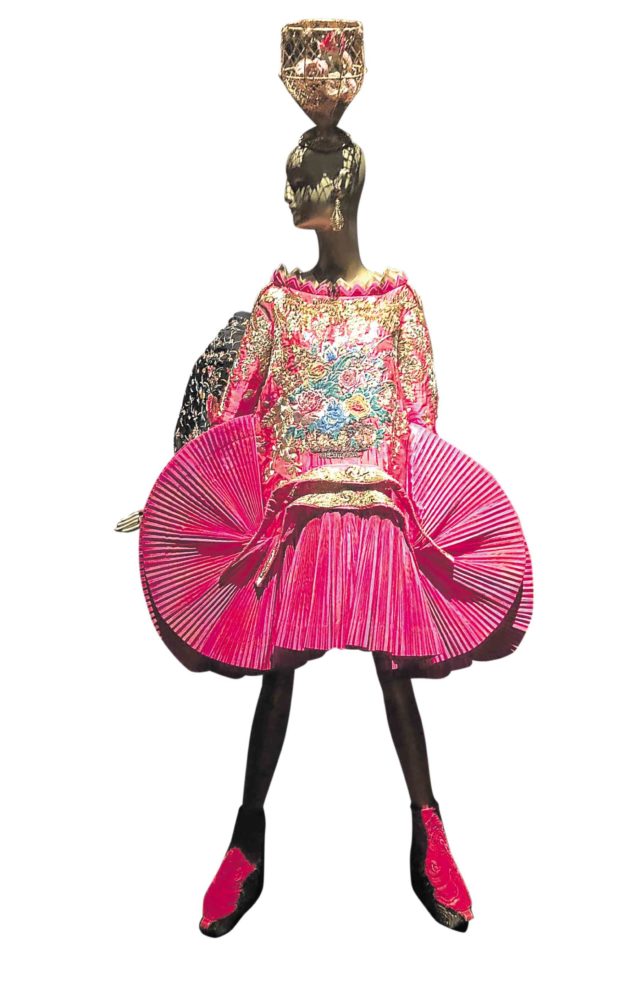
“I am not afraid of difficulties,” she said. “I feel younger. healthier than my younger peers. I feel like an Olympic athlete, but competitions are only a matter of minutes, but my work extends for hours and days and years.”
“My dream,” she declared, “is to walk as far as I can go.”
“Guo Pei: Chinese Art and Couture” is running at Singapore’s Asian Civilizations Museum until Sept. 15. Visit www.acm.org.sg.

